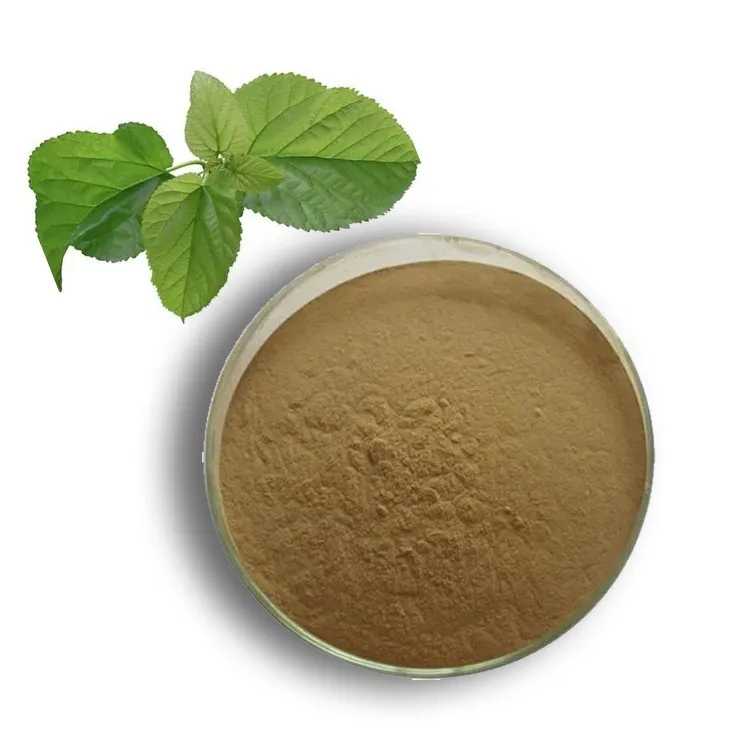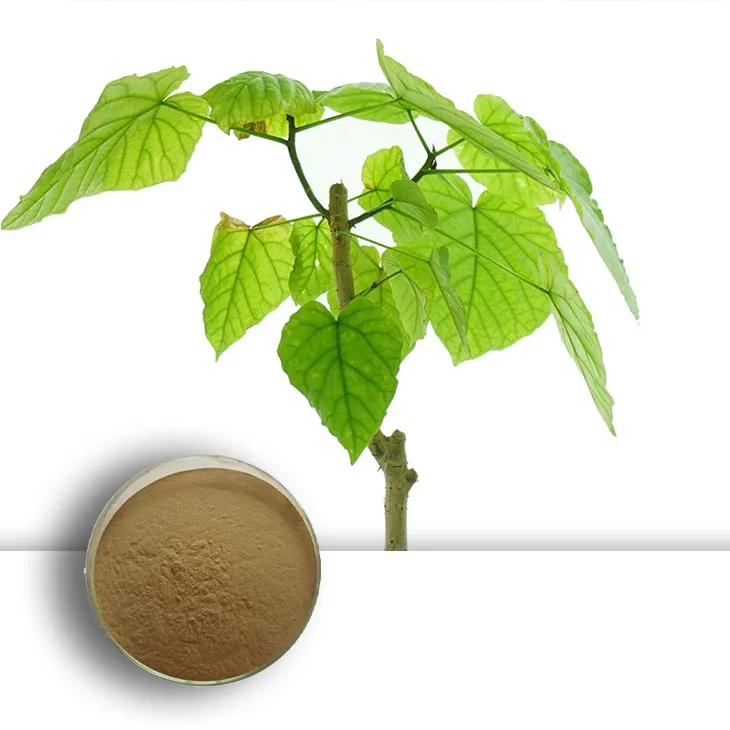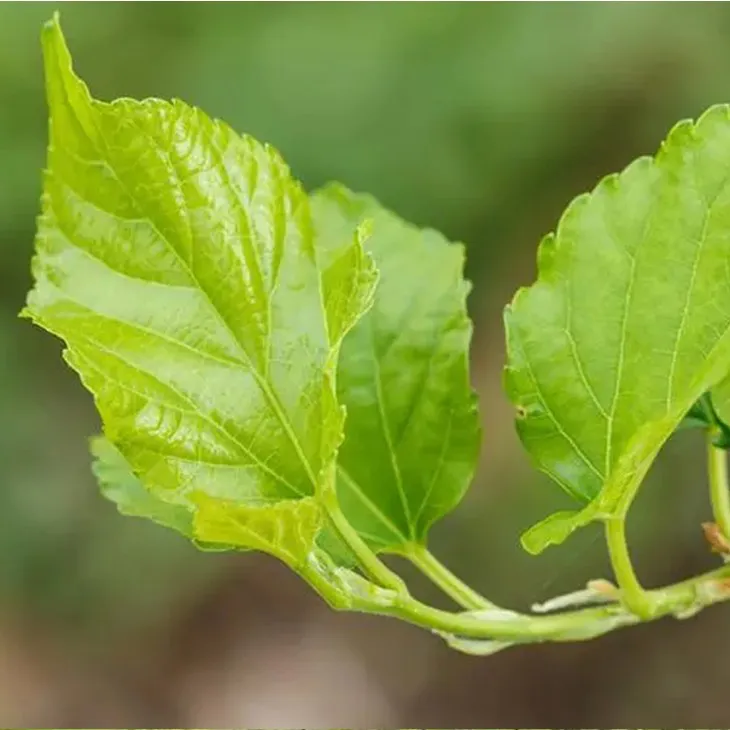- 0086-571-85302990
- sales@greenskybio.com
Mulberry Leaf Extract: From Leaf to Extraction.
2024-11-13

1. Introduction
Mulberry leaves have been used in traditional medicine for centuries in many Asian countries. In recent years, there has been a growing interest in Mulberry leaf Extract due to its potential health benefits. This extract is rich in various bioactive compounds, which are obtained through a series of processes starting from the collection of mulberry leaves. Understanding the entire process from leaf to extraction is crucial for both scientific research and industrial applications.

2. Leaf Collection
2.1. Selection of Mulberry Trees
The first step in obtaining high - quality Mulberry leaf Extract is to select the appropriate mulberry trees. Different species of mulberry trees may vary in the composition of their leaves. For example, Morus alba is one of the most commonly used species for leaf extraction. The trees should be healthy, free from diseases and pests, and grown in suitable environmental conditions.2.2. Timing of Leaf Collection
The timing of leaf collection significantly affects the quality and quantity of bioactive compounds in the leaves. Generally, young leaves are preferred as they tend to have a higher content of certain valuable substances. For instance, in spring, the mulberry leaves are often at their prime for collection as they have just emerged and are rich in nutrients. However, in some cases, mature leaves may also be used depending on the specific requirements of the extraction.2.3. Harvesting Methods
Manual harvesting is a common method for collecting mulberry leaves. This ensures that only the desired leaves are picked and helps to minimize damage to the leaves. Workers carefully pluck the leaves from the branches, avoiding any bruising or tearing. In some large - scale operations, mechanical harvesting may be used, but this requires careful calibration to prevent excessive damage to the leaves.
3. Pre - treatment of Mulberry Leaves
3.1. Cleaning
Once the leaves are harvested, they need to be thoroughly cleaned. This is to remove any dirt, dust, or other contaminants that may be present on the surface of the leaves. The leaves can be washed gently with clean water, and sometimes a mild detergent may be used if necessary. After cleaning, the leaves should be dried to remove excess moisture.3.2. Drying
Drying is an important pre - treatment step. There are different drying methods available, such as air drying, sun drying, and oven drying. Air drying is a natural method where the leaves are spread out in a well - ventilated area and allowed to dry slowly. Sun drying is also a traditional method, but it requires careful monitoring to prevent over - exposure to sunlight which can degrade some of the bioactive compounds. Oven drying can be more controlled, but the temperature and drying time need to be carefully adjusted to avoid damage to the leaves.3.3. Grinding
After drying, the leaves are often ground into a fine powder. This increases the surface area of the leaves, which is beneficial for the subsequent extraction process. The grinding can be done using a mortar and pestle for small - scale operations or a mechanical grinder for large - scale production. The resulting powder should be of a uniform particle size to ensure consistent extraction results.
4. Extraction Methods
4.1. Solvent Extraction
Solvent extraction is one of the most commonly used methods for obtaining Mulberry leaf Extract. Different solvents can be used depending on the nature of the bioactive compounds to be extracted. For example, ethanol is a popular solvent as it can effectively extract a wide range of compounds, including flavonoids and alkaloids. The process involves mixing the ground mulberry leaf powder with the solvent in a suitable container, usually at a specific ratio. The mixture is then stirred or shaken for a certain period of time to allow the compounds to dissolve into the solvent. After that, the mixture is filtered to separate the extract from the solid residue.4.2. Supercritical Fluid Extraction
Supercritical fluid extraction is a more advanced technique. In this method, a supercritical fluid, such as carbon dioxide, is used as the extracting agent. Supercritical carbon dioxide has properties that are between a gas and a liquid, which allows it to penetrate the plant material effectively and selectively extract the desired compounds. This method has the advantage of being more environmentally friendly as carbon dioxide is a non - toxic and easily recoverable gas. However, it requires more specialized equipment and higher operating costs compared to solvent extraction.4.3. Microwave - Assisted Extraction
Microwave - assisted extraction utilizes microwave energy to accelerate the extraction process. The microwaves heat the solvent and the plant material simultaneously, which increases the mass transfer rate of the bioactive compounds from the leaves to the solvent. This method can significantly reduce the extraction time compared to traditional solvent extraction methods. However, it also requires careful control of the microwave power and extraction time to avoid over - extraction or degradation of the compounds.5. Bioactive Compounds in Mulberry Leaf Extract
5.1. Flavonoids
Flavonoids are one of the major groups of bioactive compounds in mulberry leaf extract. They have antioxidant, anti - inflammatory, and anti - cancer properties. For example, rutin and Quercetin are two common flavonoids found in mulberry leaves. These flavonoids can scavenge free radicals in the body, which helps to protect cells from oxidative damage. They may also play a role in reducing inflammation in the body, which is associated with many chronic diseases.5.2. Alkaloids
Alkaloids are another important class of compounds in mulberry leaf extract. One well - known alkaloid is 1 - deoxynojirimycin (DNJ), which has been shown to have anti - diabetic properties. DNJ can inhibit the activity of certain enzymes involved in carbohydrate metabolism, which helps to regulate blood sugar levels. Other alkaloids in mulberry leaves may also have potential pharmacological effects, such as antibacterial and antiviral activities.5.3. Polyphenols
Polyphenols in mulberry leaf extract contribute to its antioxidant activity. They can also have a positive impact on cardiovascular health. For example, they may help to lower blood pressure and improve blood lipid profiles. The polyphenols in mulberry leaves are also thought to have anti - aging effects, as they can protect the skin from damage caused by ultraviolet radiation and environmental pollutants.6. Health Promotion and Disease Prevention
6.1. Diabetes Management
As mentioned earlier, the alkaloid DNJ in mulberry leaf extract has anti - diabetic properties. By inhibiting the relevant enzymes, it can help to control blood sugar levels in diabetic patients. In addition, the flavonoids and polyphenols in the extract may also contribute to improving insulin sensitivity, which is crucial for diabetes management.6.2. Cardiovascular Health
The bioactive compounds in mulberry leaf extract, such as polyphenols and flavonoids, can have a beneficial effect on the cardiovascular system. They can help to reduce oxidative stress and inflammation in the blood vessels, which are risk factors for cardiovascular diseases. Moreover, they may also help to lower cholesterol levels and improve blood vessel function.6.3. Cancer Prevention
The antioxidant properties of flavonoids and polyphenols in mulberry leaf extract may play a role in cancer prevention. These compounds can neutralize free radicals that can cause DNA damage and lead to cancer. Although more research is needed, some in - vitro and in - vivo studies have shown promising results in terms of the anti - cancer potential of mulberry leaf extract.7. Economic and Environmental Aspects
7.1. Economic Potential
The large - scale extraction of mulberry leaf extract has significant economic potential. The extract can be used in the pharmaceutical industry for the development of new drugs or dietary supplements. In the cosmetic industry, it can be incorporated into skin care products due to its antioxidant and anti - aging properties. Moreover, the growing demand for natural products also creates a market opportunity for mulberry leaf extract.7.2. Environmental Considerations
From an environmental perspective, mulberry trees are relatively easy to grow and require less water and pesticides compared to some other crops. The extraction process, especially when using environmentally friendly methods such as supercritical fluid extraction, can also be more sustainable. However, large - scale extraction may also have some environmental impacts, such as the disposal of solvent waste in solvent extraction methods. Therefore, proper waste management and the development of more sustainable extraction processes are important.8. Conclusion
In conclusion, the process of obtaining mulberry leaf extract from leaf to extraction involves multiple steps, including leaf collection, pre - treatment, and extraction methods. The extract is rich in bioactive compounds that have potential health benefits in terms of health promotion and disease prevention. From an economic and environmental perspective, the large - scale extraction of mulberry leaf extract has both opportunities and challenges. Further research is needed to fully explore the potential of mulberry leaf extract and to develop more sustainable extraction and application methods.
FAQ:
What are the main steps in the pre - treatment of mulberry leaves for extraction?
The pre - treatment of mulberry leaves for extraction typically involves steps such as cleaning to remove dirt, debris, and other impurities. Then, drying may be carried out to reduce the moisture content, which can help in subsequent extraction processes. Sometimes, the leaves may also be ground into a fine powder to increase the surface area available for extraction.
What are the common extraction methods used for mulberry leaf extract?
Common extraction methods for mulberry leaf extract include solvent extraction, where solvents like ethanol or water are used to dissolve the bioactive compounds from the leaves. Another method is supercritical fluid extraction, which uses supercritical carbon dioxide. This method has the advantage of being more environmentally friendly and can produce a high - quality extract. Microwave - assisted extraction is also sometimes used, which can speed up the extraction process by using microwave energy to enhance the transfer of compounds from the leaves to the solvent.
What are the main bioactive compounds in mulberry leaf extract?
The main bioactive compounds in mulberry leaf extract include flavonoids such as rutin and Quercetin. These flavonoids have antioxidant properties. Additionally, alkaloids like 1 - deoxynojirimycin (DNJ) are present, which has been studied for its potential role in blood sugar regulation. There are also polysaccharides in the extract, which may have immunomodulatory effects.
How does mulberry leaf extract contribute to health promotion?
Mulberry leaf extract contributes to health promotion in several ways. Due to its antioxidant bioactive compounds, it can help in reducing oxidative stress in the body. The presence of DNJ may assist in regulating blood sugar levels, which is beneficial for individuals at risk of diabetes. The immunomodulatory effects of polysaccharides can enhance the body's immune system, helping to prevent diseases. Flavonoids may also have anti - inflammatory properties, which can contribute to overall health.
What are the economic benefits of large - scale extraction of mulberry leaf extract?
The large - scale extraction of mulberry leaf extract has several economic benefits. It can create new business opportunities in the agricultural and pharmaceutical industries. Farmers can earn additional income by growing mulberry trees specifically for leaf extraction. In the pharmaceutical and nutraceutical sectors, the extract can be used to develop new products, which can lead to increased revenue. It can also promote the development of related industries such as extraction equipment manufacturing and packaging.
Related literature
- Bioactive Compounds in Mulberry Leaves and Their Potential Health Benefits"
- "Extraction Techniques for Mulberry Leaf Extract: A Review"
- "The Economic Impact of Mulberry Leaf Extract Production on Rural Areas"
- ▶ Hesperidin
- ▶ citrus bioflavonoids
- ▶ plant extract
- ▶ lycopene
- ▶ Diosmin
- ▶ Grape seed extract
- ▶ Sea buckthorn Juice Powder
- ▶ Beetroot powder
- ▶ Hops Extract
- ▶ Artichoke Extract
- ▶ Reishi mushroom extract
- ▶ Astaxanthin
- ▶ Green Tea Extract
- ▶ Curcumin Extract
- ▶ Horse Chestnut Extract
- ▶ Other Problems
- ▶ Boswellia Serrata Extract
- ▶ Resveratrol Extract
- ▶ Marigold Extract
- ▶ Grape Leaf Extract
- ▶ blog3
- ▶ blog4
- ▶ blog5
-
Organic Tongkat Ali extract powder factory.
2024-11-13
-
How to make powder with ashwagandha extract.
2024-11-13
-
Rosehip extract manufacturers from China.
2024-11-13
-
The best cat's claw extract in nature.
2024-11-13
-
Chinese Dandelion Leaf Extract Suppliers.
2024-11-13
-
Yellow Pine Extract
2024-11-13
-
Agaricus Blazei Extract
2024-11-13
-
Rose Hip Extract
2024-11-13
-
Green Tea Extract
2024-11-13
-
Konjac Powder
2024-11-13
-
Genistein
2024-11-13
-
Marigold Extract
2024-11-13
-
Centella Asiatica Extract
2024-11-13
-
Cat Claw Extract
2024-11-13
-
Cassia Seed Extract
2024-11-13





















